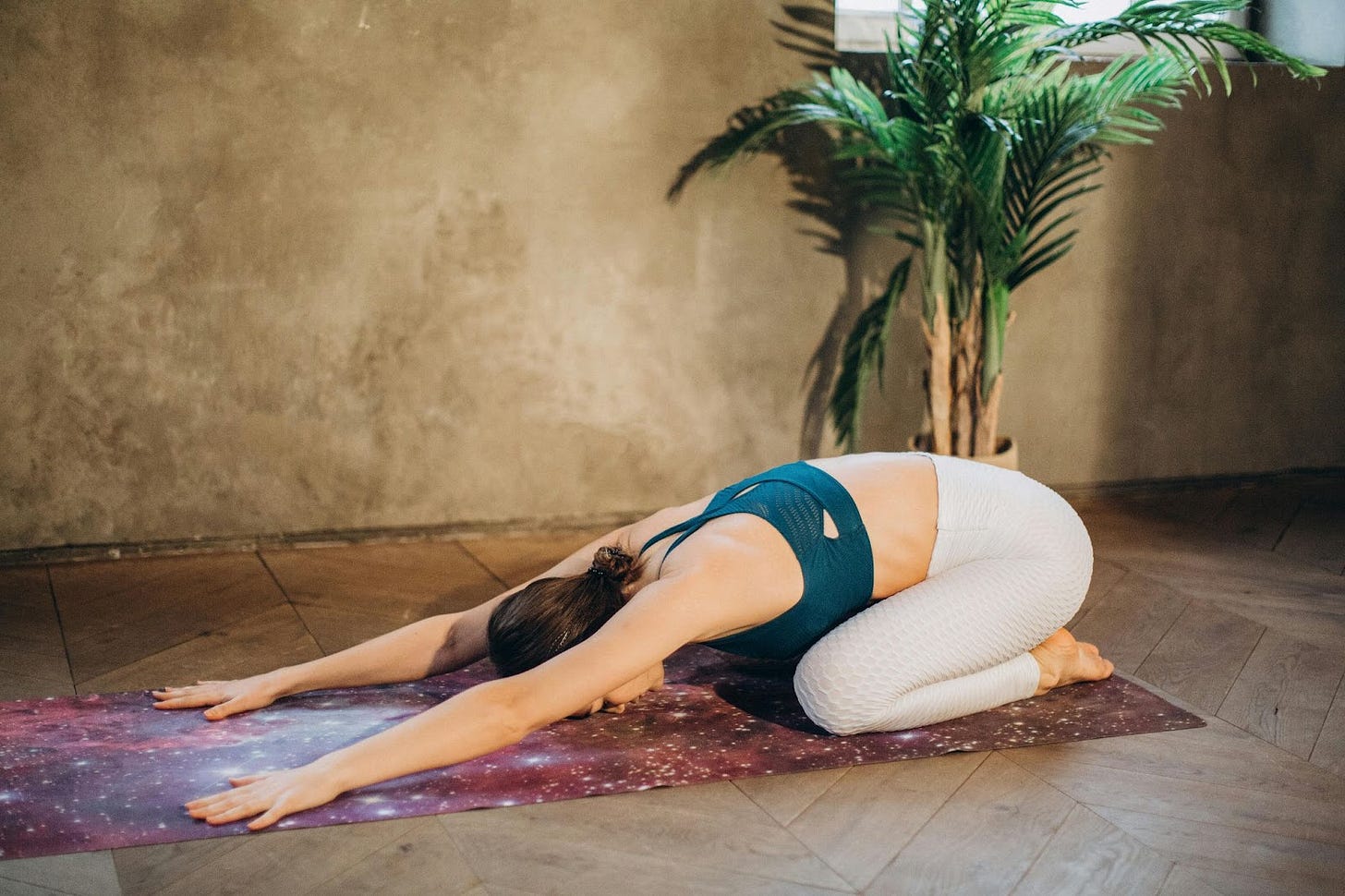The Child's Breath: A Calming Pose
For too many of my clients, the root cause of most dysfunctions is stress. The challenge with stress is that it’s so challenging to ascertain where it comes from that the solutions that worked for one person may not work for you. In fact, I find that there’s rarely ever one source of stress, leading to it being hard to figure out what key factors move the needle enough to alleviate the stress.
One of the biggest root causes of stress is dysfunctional breathing patterns, and often as a result of sitting too much. Dysfunctional breathing patterns can lead the body into chronic adaptations like tight hips, low back tension, digestive sluggishness, and even anxiety. But too often, people try to treat their low back pain, without understanding the proper root cause of the issue. This can lead to the treatment only working for a few weeks, yet returning worse than before.
This article will explain a few of the reasons why the pelvic floor is often the root cause of these breathing dysfunctions, and a key exercise that helps to not only unlock the pelvic floor, but can restore breathing patterns back to optimal function, and get your body to move from stress back to calm.
Why the Pelvic Floor Matters (Even If You’ve Never Thought About It)
The pelvic floor is a group of muscles and connective tissue that form a kind of hammock at the bottom of your pelvis. It supports your internal organs, contributes to your core strength, and helps regulate functions like urination, bowel movements, and even sexual pleasure.
But it does more than just support physical functions. The pelvic floor is part of your body’s emotional and nervous system landscape. When you’re stressed, anxious, or holding back feelings, these muscles can tighten reflexively and stay that way. Over time, a chronically contracted pelvic floor can contribute to dysfunction: pain, tension, digestive issues, and even a lack of mobility in your hips and spine.
If you sit a lot, these muscles rarely get stretched or released. They’re tucked, compressed, and disconnected from your daily awareness.
Breathing Involves the Whole Core
Most of us think of breathing as something that happens in the lungs and ribs. But true, functional breathing is a full-body experience that includes your diaphragm, belly, back, and your pelvic floor.
On the inhale, your diaphragm moves downward, creating space in your lungs to fill with air. As it moves down, it pushes gently on your abdominal contents and signals the pelvic floor to stretch and expand. On the exhale, the diaphragm recoils upward and the pelvic floor rebounds gently, helping to regulate pressure in the abdomen.
This movement relationship between the diaphragm and pelvic floor is sometimes described as a piston: up and down, coordinated, effortless. When everything is working well, it contributes to healthy core mechanics, efficient movement, and a calm nervous system.
But if you’re constantly bracing your stomach, sitting in a slouched posture, or shallow-breathing from your chest (which is common under stress), this connection is lost. The pelvic floor stops moving with your breath. Over time, this can lead to tightness, disuse, or dysfunctional patterns.
Why Child’s Pose Is the Perfect Reset Button
Child’s Pose, also known as Balasana in yoga, is a gentle, resting posture that positions your body in a folded-forward shape with the knees apart and the forehead grounded.
This simple position invites the spine to decompress, the hips to soften, and the belly to feel supported. Most importantly, it allows the pelvic floor to let go. Gravity helps open the back of the body, especially the lower spine and sacrum area where many people feel stiffness or tension. With the belly resting on the thighs or on a pillow, your body feels safe to breathe down and back, right into the pelvic bowl.
This position also calms the autonomic nervous system, encouraging a shift from sympathetic (fight or flight) to parasympathetic (rest and digest). And that shift is necessary for the pelvic floor to relax.
How to Breathe in Child’s Pose for Pelvic Floor Health
Start by kneeling on the floor or a mat. Bring your big toes to touch and spread your knees apart to make space for your belly. Sit back on your heels, using a cushion between heels and hips if needed, then fold forward and rest your forehead on the floor, a block, or a pillow. Your arms can stretch forward or rest by your sides.
Begin by simply noticing your breath. With each inhale, imagine your breath traveling down to your tailbone, into your hips, and gently expanding the bowl of the pelvis. With each exhale, allow everything to soften. Don’t force a contraction; just let go.
Stay in this position for at least one minute, and work up to three to five minutes over time. Notice if your lower back begins to feel more fluid. See if you can sense the breath subtly widening your sit bones.
If it helps, think of cues like "breathe into your tailbone," or "let your pelvic floor bloom on the inhale and settle on the exhale."
What You Might Feel
Many people report a softening of the hips or tailbone area. Some feel gentle tingling or warmth in the pelvic region. Others experience emotional release in the form of sighs, tears, or unexpected calm. You may notice an improved ability to breathe into the belly and sides of the ribs, or a general sense of being grounded, present, and safe.
As this practice becomes more regular, you may also begin to feel subtle shifts in how you move through your day. Physical tasks can feel more fluid. Your posture may become more upright without force. Emotional stressors might not hit as hard or linger as long. There’s often a quiet confidence that comes from simply being more connected to your base.
When the pelvic floor is engaged in healthy movement and rhythm, the brain makes feeling the body easier, and less stressful. It’s almost as if you're fighting your own structure less. None of this is forced. It’s not a stretch in the traditional sense, but it’s reconnecting the brain to the body.
Bigger Picture: Breath as a Nervous System Practice
When you learn to breathe with your pelvic floor instead of around it, you tap into one of your body’s most profound systems of self-regulation. This kind of breath work can decrease chronic tension in the low back and hips, support digestion by activating the vagus nerve, reduce anxiety and stress by regulating the autonomic nervous system, improve posture and coordination by reintegrating your core, and create better awareness and control over your pelvic and abdominal region.
It doesn’t take hours of yoga or breathwork training to feel the difference. Just a few minutes in Child’s Pose each day can start to rewire this deep, foundational connection.
Try It Today
Next time you find yourself drained from a long day of sitting, scrolling, or thinking too hard, give yourself the gift of stillness.
Kneel, fold, breathe.
Let your breath go where sitting never lets it.
Let your body remember how to soften.
Let your pelvic floor become part of your breathing life again.
Let it all return to rhythm.
If you liked this, check out my course at Four Lights Wellness, where I cover both physical and mental aspects of wellness: Healing (e)Motions: Trauma Release Exercises for People with Stress offers targeted physiological exercises aimed at reducing stress and mental health dysfunctions that can contribute to physical pain.





